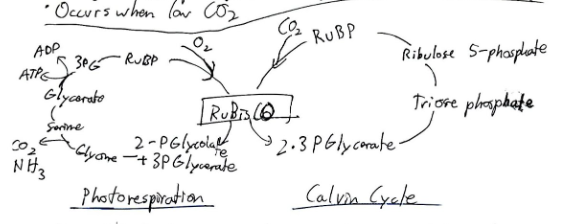Photosynthesis Reactions 10/15
Two Sets of Reactions:
Light Dependent Reactions
Occur in the thylakoid membrane
Require light
Produce ATP and NADPH
Calvin Cycle (Light Independent)
Occurs in the stroma
Process where enzymes reduce CO₂ into carbohydrates
Requires ATP, NADPH, and CO₂
Key Terms:
NADP+: Molecule that accepts and delivers 2 electrons and 1 hydrogen ion (H⁺).
Reduction: The process of gaining electrons.
Oxidation: The process of losing electrons.
ATP Cycle:
ATP (Adenosine Triphosphate): High energy molecule with 3 phosphate groups.
ADP (Adenosine Diphosphate): Lower energy molecule with 2 phosphate groups.
Light Dependent Reactions:
Water Splitting (Photolysis)
Water is split at PSII, donating electrons to PSII.
Oxygen atoms are released as O₂.
Hydrogen ions (H⁺) build up in concentration in the lumen.
Light Absorption
Light is absorbed by pigments in PSII.
Energy transfers to electrons in the reaction center, energizing them.
Electron Transport Chain (ETC)
Electrons move down the ETC.
Photosystem I (PSI)
PSI accepts electrons from the ETC.
Light is absorbed by pigments, reenergizing the electrons.
Electron Transport Chain: a series of protein complexes and other molecules that transfer electrons through a membrane within mitochondria (in cellular respiration) or thylakoids (in photosynthesis). This process is critical for generating ATP, the energy currency of the cell.
Photosynthesis Notes
NADP Reductase:
Electrons pass through the membrane protein called NADP reductase.
Lumen Function:
The lumen acts as a hydrogen ion reservoir.
Hydrogen ions (H⁺) move through ATP synthase.
ATP Synthase:
ATP synthase catalyzes the bonding of ADP and an inorganic phosphate (Pi) to produce ATP.
Chemiosmosis: Movement of ions down a chemical gradient.
Final Products:
The main products of the light-dependent reactions are ATP and NADPH.
RuBisCO:
RuBisCO is the enzyme that fixes carbon into ribulose bisphosphate (RuBP).
Carbon Reduction:
ATP and NADPH, produced from the light-dependent reactions, are used in the Calvin Cycle.
3PGA (3-phosphoglycerate) undergoes reduction to form PGAL (phosphoglyceraldehyde) and G3P (glyceraldehyde-3-phosphate). These are essentially the same molecule.
Organic Molecule Production:
The 3PGA molecules are starting materials for many organic molecules.
They help produce starch, cellulose, sucrose, and plant oils.
Two G3P molecules combine to form one glucose molecule.
Photorespiration and Calvin Cycle Notes
Photorespiration:
Definition: Occurs when Rubisco fixes O₂ instead of CO₂, leading to a loss of CO₂.
Conditions: More likely to happen when CO₂ levels are low and O₂ levels are high.
Impact on Plants: Not beneficial, as it reduces the efficiency of photosynthesis and wastes energy.
Key Molecules:
RUBP: Ribulose bisphosphate, the substrate for Rubisco.
3-PGA: 3-Phosphoglycerate, a product formed in the Calvin Cycle.
Triose Phosphate: Includes molecules like G3P (Glyceraldehyde-3-phosphate).
2-PG: 2-Phosphoglycolate, a byproduct of photorespiration.
Calvin Cycle Overview:
Main Steps:
CO₂ is fixed by Rubisco into RUBP.
Forms 3-PGA, which is then converted into triose phosphates using ATP and NADPH.
Outputs: Sugars and other organic molecules.
Evolutionary Context:
Photorespiration evolved when atmospheric O₂ levels were lower and did not significantly harm plants.
As O₂ levels increased, the inefficiency of photorespiration became more problematic for plants.
Cyanobacteria evolved processes that produced sugars and oxygen, contributing to the rise in atmospheric O₂ levels.
Significance of Oxygen Increase:
The increase in O₂ allowed for the evolution of complex life forms and aerobic organisms.
Anaerobic life forms declined as a result of rising oxygen levels.
